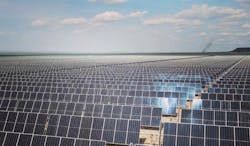Solar, the Final Frontier, flourishing in Oil Sands region of Canada
It sounds illogical, but one of Canada’s largest solar farms is now one of several utility-scale projects generating carbon-free power in the heart of oil sands country.
The 465-MW Travers Solar project, managed by Axium Infrastructure, has capacity to offset 674,000 metric tons of carbon emissions annually. It is located in Vulcan County, Alberta, an area known for displays honoring Star Trek culture and not far from the center of activity for the oil sands production.
Travers Solar is operating under a 15-year power purchase agreement with Amazon for 400 MW, representing 86 percent of capacity.
Three other renewable energy projects in Vulcan County are the 300 MW EDF Renewables and Enbridge Blackspring Ridge Wind Farm; the 514 MW Buffalo Plains Wind Farm, under construction and the planned 22 MW Vulcan GP2 solar farm. The projects support around 20 construction jobs.
“One of the nice things with these renewables that have come to the county as of late is they make up for a shortfall in our [tax] assessment,” said Nels Petersen, chief administrative officer of Vulcan County. "The 1.3 million-panel project will generate around $3 million per year in taxes for the county, needed money to help maintain the county’s 1,800 miles of gravel roads and other infrastructure. As the total assessment base grows, our taxes [on residents] are dropping."
Axium Infrastructure acquired the Travers Solar property from Copenhagen Infrastructure Partners in a transaction announced earlier this year.
Greek firm Mytilineos is planning a $1.7 billion project to build five solar power facilities in southern and central Alberta. The project will have capacity to produce 1.4 GW, enough electricity for around 200,000 homes, and is expected to be completed by 2027.
"Many new companies are exploring the possibility of developing more projects in the county," said Jason Schneider, reeve (equivalent of mayor) of Vulcan County, in a story by James Snell for Canadian Energy Centre’s website. "You definitely don’t want to turn away development, but there is a point when you say, I don’t know how many more of these we can support. One of the concerns is the future reclamation of the projects."
Click here to read the complete story at Canadian Energy Centre.
About the Author
EnergyTech Staff
Rod Walton is senior editor for EnergyTech.com. He has spent 17 years covering the energy industry as a newspaper and trade journalist.
Walton formerly was energy writer and business editor at the Tulsa World. Later, he spent six years covering the electricity power sector for Pennwell and Clarion Events. He joined Endeavor and EnergyTech in November 2021.
He can be reached at [email protected].
EnergyTech is focused on the mission critical and large-scale energy users and their sustainability and resiliency goals. These include the commercial and industrial sectors, as well as the military, universities, data centers and microgrids.
Many large-scale energy users such as Fortune 500 companies, and mission-critical users such as military bases, universities, healthcare facilities, public safety and data centers, shifting their energy priorities to reach net-zero carbon goals within the coming decades. These include plans for renewable energy power purchase agreements, but also on-site resiliency projects such as microgrids, combined heat and power, rooftop solar, energy storage, digitalization and building efficiency upgrades.
